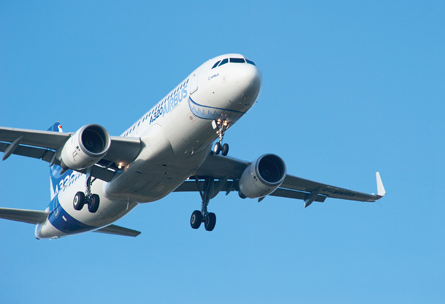Airbus is expecting the first new-build aircraft for its A320 sharklets wing-tip programme to join the test regime in May, after promising results from initial flights with an early airframe.
More than 100 flight hours of tests have been conducted with the first aircraft, A320 MSN1, which was rolled out with the modifications last November.
"The programme is running well. The first part has been successfully and intensively followed," said Airbus head of development flight tests Hugues Van der Stichel. "The envelope has been checked successfully and the behaviour of the sharklet is very satisfactory."
 |
|---|
© Airbus Airbus is expecting the first new-build aircraft for its A320 sharklets wing-tip programme to join the test regime in May |
He said the airframer has carried out modelling and simulation as part of the certification work to have a "proper representation" of the aircraft. The simulation effort has focused on establishing, for example, roll-handling parameters and aerodynamic loading to see whether fine-tuning was necessary. Crucially, Airbus wants the handling qualities of the A320 to remain unchanged by the sharklet modification.
"We have performed necessary identification of all parameters," said Van der Stichel. "All low-speed identifications have been made, stalls were performed, and these are showing very good behaviour of the aircraft.
"We are shortly to check the behaviour of the aircraft in icing conditions, in the coming weeks."
Airbus sharklet programme vice-president Pierre-Marie Gluckler added: "The sharklet is modifying the aerodynamic performance of the aircraft and its handling qualities. We built computational models to tune the controls, the autopilot, and so on.
"We are checking all assumptions made by the engineers, checking our simulations and flight models. We are quite happy with the results and the simulations."
Flight tests range in duration from as little as 30min - for minimum control speed tests - up to several hours. Typically, the A320 carries a crew of four to six personnel, and checks conducted so far have included the take-off, cruise, approach and landing phases.
"In parallel we've measured the high-speed performance of the aircraft," said Gluckler.
While fuel-burn figures depend on the flight profile, initial results from the tests indicate the sharklets are saving more than 3.5% in fuel-burn over sectors of 2,000nm (3,700km) - the main objective of the modification. "We are meeting this," said Gluckler, adding that the airframer has carried out "back-to-back" test flights using both the sharklets and regular wing-fences.
"We have to be careful with the expectations you give to people [on fuel-burn]," pointed out Van der Stichel. "We are on the right side of what we expected, a good signal that design and assumptions are correct."
Eight aircraft, including MSN1, will participate in the flight-test regime - one of each A320-family airframe, with both current engine options. MSN1, which has been "opening most of the doors", will continue to operate until April, said Gluckler, and the first new sharklet-ready aircraft will become available in May.
"The wing reinforcement is available and the new aircraft will be on the final assembly line in a month," he added.
While the sharklets are also designed to improve the A320's take-off performance, Gluckler said Airbus was too early into the testing to give specific data. However, he stressed that the modified wing-tips appeared to be meeting expectations: "We've not discovered any significant issues that would change the plan."
Source: Flight International























